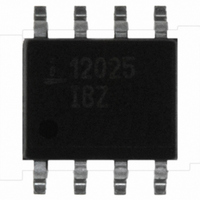ISL12025IBZ Intersil, ISL12025IBZ Datasheet - Page 22

ISL12025IBZ
Manufacturer Part Number
ISL12025IBZ
Description
IC RTC/CALENDAR EEPROM 8-SOIC
Manufacturer
Intersil
Type
Clock/Calendar/Supervisor/EEPROMr
Specifications of ISL12025IBZ
Memory Size
4K (512 x 8)
Time Format
HH:MM:SS (12/24 hr)
Date Format
YY-MM-DD-dd
Interface
I²C, 2-Wire Serial
Voltage - Supply
2.7 V ~ 5.5 V
Operating Temperature
-40°C ~ 85°C
Mounting Type
Surface Mount
Package / Case
8-SOIC (3.9mm Width)
Bus Type
Serial (I2C)
Operating Supply Voltage (typ)
3.3V
Operating Supply Voltage (max)
5.5V
Operating Supply Voltage (min)
2.7V
Operating Temperature Classification
Industrial
Operating Temperature (max)
85C
Operating Temperature (min)
-40C
Pin Count
8
Mounting
Surface Mount
Clock Format
HH
Clock Ic Type
RTC
Interface Type
I2C, Serial
Memory Configuration
512 X 8
Supply Voltage Range
2.7V To 5.5V
Digital Ic Case Style
SOIC
Rohs Compliant
Yes
Lead Free Status / RoHS Status
Lead free / RoHS Compliant
Layout Considerations
The crystal input at X1 has a very high impedance and will
pick up high frequency signals from other circuits on the
board. Since the X2 pin is tied to the other side of the crystal,
it is also a sensitive node. These signals can couple into the
oscillator circuit and produce double clocking or
mis-clocking, seriously affecting the accuracy of the RTC.
Care needs to be taken in layout of the RTC circuit to avoid
noise pickup. Figure 27 shows a suggested layout for the
ISL12025 or ISL12027 devices.
The X1 and X2 connections to the crystal are to be kept as
short as possible. A thick ground trace around the crystal is
advised to minimize noise intrusion, but ground near the X1
and X2 pins should be avoided as it will add to the load
capacitance at those pins. Keep in mind these guidelines for
other PCB layers in the vicinity of the RTC device. A small
decoupling capacitor at the V
with a solid connection to ground (see Figure 27).
Oscillator Measurements
When a proper crystal is selected and the layout guidelines
above are observed, the oscillator should start up in most
circuits in less than one second. Some circuits may take
slightly longer, but startup should definitely occur in less than
5s. When testing RTC circuits, the most common impulse is
to apply a scope probe to the circuit at the X2 pin (oscillator
output) and observe the waveform. DO NOT DO THIS!
Although in some cases you may see a usable waveform,
due to the parasitics (usually 10pF to ground) applied with
the scope probe, there will be no useful information in that
waveform other than the fact that the circuit is oscillating.
Frequency
Frequency Tolerance
Turnover Temperature
Operating Temperature Range
Parallel Load Capacitance
Equivalent Series Resistance
Citizen
Epson
Raltron
SaRonix
Ecliptek
ECS
Fox
MANUFACTURER
PARAMETER
CM201, CM202, CM200S
MC-405, MC-406
RSM-200S-A or B
32S12A or B
ECPSM29T-32.768K
ECX-306/ECX-306I
FSM-327
DD
22
TABLE 7. CRYSTAL PARAMETERS REQUIRED FOR INTERSIL RTC’S
pin of the chip is mandatory,
PART NUMBER
MIN
-40
20
TABLE 8. CRYSTAL MANUFACTURERS
32.768
TYP
12.5
25
ISL12025
MAX
±100
30
85
50
The X2 output is sensitive to capacitive impedance so the
voltage levels and the frequency will be affected by the
parasitic elements in the scope probe. Applying a scope
probe can possibly cause a faulty oscillator to start-up,
hiding other issues (although in the Intersil RTC’s, the
internal circuitry assures startup when using the proper
crystal and layout).
The best way to analyze the RTC circuit is to power it up and
read the real-time clock as time advances. Alternatively the
frequency can be checked by setting an alarm for each
minute. Using the pulse interrupt mode setting, the
once-per-minute interrupt functions as an indication of
proper oscillation.
TEMP RANGE
FIGURE 27. SUGGESTED LAYOUT FOR INTERSIL RTC IN SO-8
-40 to +85°C
-40 to +85°C
-40 to +85°C
-40 to +85°C
-10 to +60°C
-10 to +60°C
-40 to +85°C
UNITS
ppm
kHz
k
°C
°C
pF
Ω
Down to 20ppm if desired
Typically the value used for most crystals
For best oscillator performance
+25°C FREQUENCY TOLERANCE
32.768KH
XTAL1
X1226SOIC
R
1
U
Z
NOTES
1
±20ppm
±20ppm
±20ppm
±20ppm
±20ppm
±20ppm
±20ppm
10k
August 13, 2008
C
01µF
FN6371.3
1








